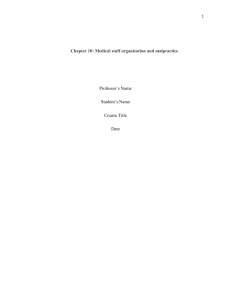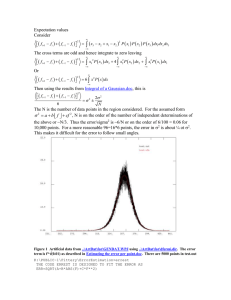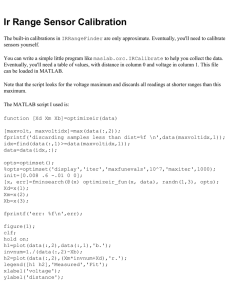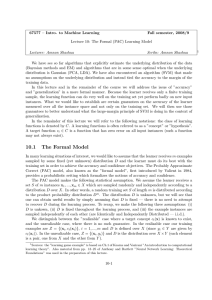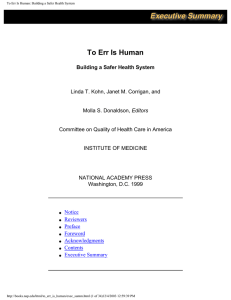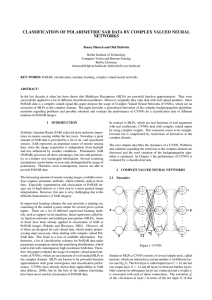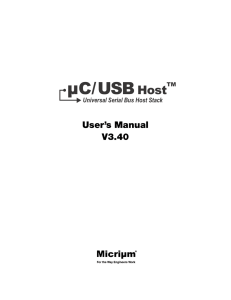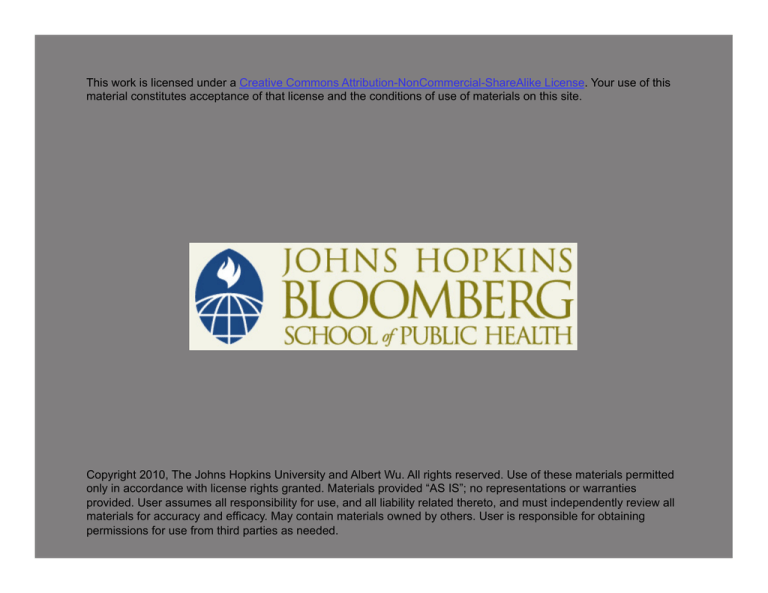
This work is licensed under a Creative Commons Attribution-NonCommercial-ShareAlike License. Your use of this
material constitutes acceptance of that license and the conditions of use of materials on this site.
Copyright 2010, The Johns Hopkins University and Albert Wu. All rights reserved. Use of these materials permitted
only in accordance with license rights granted. Materials provided “AS IS”; no representations or warranties
provided. User assumes all responsibility for use, and all liability related thereto, and must independently review all
materials for accuracy and efficacy. May contain materials owned by others. User is responsible for obtaining
permissions for use from third parties as needed.
Where Are We Now?
Albert Wu, MD, MPH
Johns Hopkins University
Five Ten Years Later
Lucian L. Leape and Donald M. Berwick’s Five Years after “To Err Is
Human”: What Have We Learned?*
*Leape, Lucian L., and Berwick, Donald M. (2005, May 18). Five years
after “To err is human”: What have we learned? Journal of the
American Medical Association, 293, 19, 2384–2390.
3
What Have We Accomplished?
Wider recognition in health care that medical errors are a serious
problem
Engagement of important stakeholders
- Federal government
- Veterans Health Administration
- Joint Commission
Understanding that the most effective method to improve safety
and quality is to change systems
Accelerated implementation of safe care practices
4
Clinical Effectiveness of Safe Practices: Isolated Evidence
CPOE
- 81% reduction in medication errors
Bates, 2003, NEJM
Protocol enforcement
- 95% reduction in central venous line infections
Pronovost, 2005
Team training in labor and delivery
Sachs, 2005
5
Limited Improvement
Fewer deaths from concentrated KCl
Fewer complications from warfarin
Fewer hospital-acquired infections
6
In the UK
Reduction in mortality
- Overall hospital standardized mortality ratios
1996–1997: 114
2006–2007: 82
- Reduction in cardiac surgery mortality
1997–1998: 2.4%
2004–2005: 1.8%
MRSA bacteremia rates rose steadily until 2002, now falling
BUT, 7 of 9 safety indicators show an increase (probably reflecting
better coding)
7
Payment Incentives?
Centers for Medicare and Medicaid Services (CMS)
- Reward hospitals and physicians that achieve high levels of
safety?
Central line infections, ventilator-associated pneumonia,
surgical-site infections
- New policy of not paying for specific complications
8
So Is Health Care Safer?
Overall, not much
9
Health Care Has Become Complex
Technological and medical progress
A specialized, complex environment
Inpatients are seen by dozens of providers each day
Outpatients may see a dozen different physicians
10
Why Is It So Difficult?
Why is it so difficult to implement practices and policies to deliver
safe health care?
- Culture of medicine
Autonomy
Professional fragmentation
Positivism/progress via research
- Lack of leadership
- Fear
11
Backlash
“It’s the system”
vs.
“The major cause of bad care is bad doctors and nurses”
12
Information
Despite numerous initiatives to improve patient safety, we have
little idea whether they have worked
Lack of good measures
No comprehensive national monitoring system for patient safety
13
The End of the Beginning—A Long Way to Go
The End Of The Beginning:
Patient Safety Five Years After
‘To Err Is Human’*
Amid signs of progress, there is still a long way to go."
By Robert M. Wachter!
*Health Affairs. (2004).
14
How Are We Doing – Half full or half empty?
Photo by Rob Hayes. Creative Commons BY-NC-SA.
15
Give It a Grade
Regulations
Reporting systems
Clinical information technology
Malpractice and other vehicles for accountability
Workforce and training
16
Regulation: A
JC with stronger, more specific
regulations
In an individualistic culture with
the absence of financial
incentives, regulation is a first
step
“Sign your site”
But next steps are harder
Image source: American Academy of Orthopaedic Surgeons.
17
Reporting Systems: C
Reports can be powerful tools
Many organizations lack any programs to follow up reports and make
meaningful changes
18
Information Technology: B
Wider implementation with some notable successes
High up-front costs
Unintended consequences
19
Malpractice System: D
The malpractice system is broken
Both negative and positive impacts on safety overrated?
Lack of accountability: a continuing problem
20
Workforce and Training: B
New care models are promising: hospitalists, intensivists
Work-hour limits are sensible
Data link nurse-force issues with safety
Training and simulation: promising but underused
21
Overall Grade
Overall patient safety five years after the IOM report:
C+
22
Goals
Change in consciousness and culture
Ubiquitous education about safety
Reformed system of compensation for injury
A major effort to develop safety measures
Expanding evidence base for safe, high-quality care
Positive incentives for quality
23
Assess Trends in Safety Issues?
Annual review of medical records to monitor trends in adverse
events
Screening program for drug errors of a sample of patients
Clinician coding to identify proportion of patient admissions due to
adverse drug events
24
This Is Not the End
“This is not the end. It is not even the beginning of the
end. But it is, perhaps, the end of the beginning.”
— Winston Churchill
At the Lord Mayor’s Luncheon
November 10, 1942
25
Where Are We Now?
26


